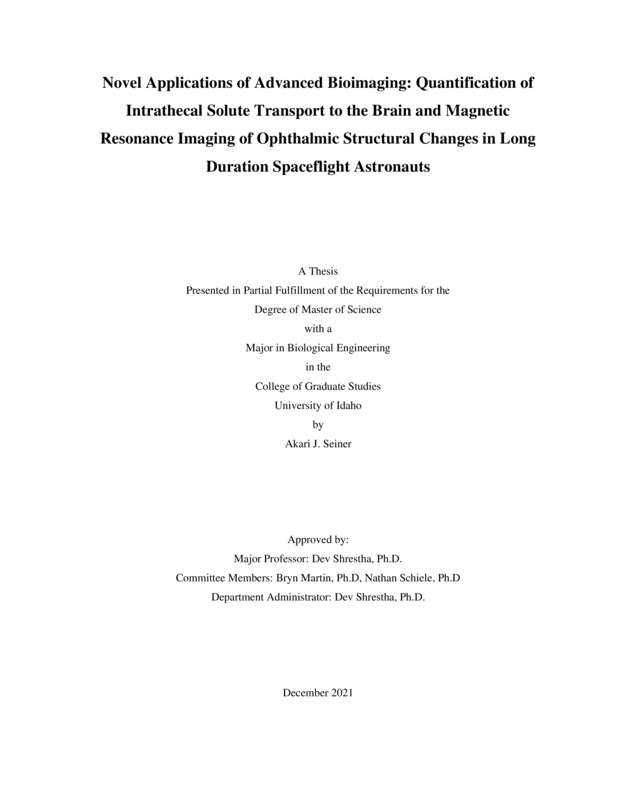Novel Applications of Advanced Bioimaging: Quantification of Intrathecal Solute Transport to the Brain and Magnetic Resonance Imaging of Ophthalmic Structural Changes in Long Duration Spaceflight Astronauts
SEINER, AKARI. (2021-12). Novel Applications of Advanced Bioimaging: Quantification of Intrathecal Solute Transport to the Brain and Magnetic Resonance Imaging of Ophthalmic Structural Changes in Long Duration Spaceflight Astronauts. Theses and Dissertations Collection, University of Idaho Library Digital Collections. https://www.lib.uidaho.edu/digital/etd/items/seiner_idaho_0089n_12263.html
- Title:
- Novel Applications of Advanced Bioimaging: Quantification of Intrathecal Solute Transport to the Brain and Magnetic Resonance Imaging of Ophthalmic Structural Changes in Long Duration Spaceflight Astronauts
- Author:
- SEINER, AKARI
- Date:
- 2021-12
- Embargo Remove Date:
- 2022-12-21
- Keywords:
- bioimaging Central nervous system disease
- Program:
- Biological & Agricultural Engineering
- Subject Category:
- Biomedical engineering; Biology
- Abstract:
-
The field of bioimaging science has been continually evolving over the recent years. Typically, bioimaging is used to noninvasively visualize biological processes in real time at multiple resolutions. Commonly used imaging techniques include those based in optics, photonics, magnetic resonance, spectroscopy, and others. Imaging processing and analysis are an integral part of bioimaging and allows for the quantification of anatomical and physiologically relevant parameters. In this thesis, we propose two novel applications of bioimaging: (1) quantification of intrathecal solute transport to the brain in a human model and (2) quantification of ophthalmic structural changes in long duration spaceflight astronauts. To address the first aim, a T2-weighted magnetic resonance imaging (MRI) sequence was used to acquire anatomical and cerebrospinal fluid (CSF) flow data. An optically clear 3D in vitro human model of the CSF in the subarachnoid space and subject specific oscillatory CSF flow waveforms were developed from the sequence. Several intrathecal drug delivery (ITDD) parameters, including (a) bolus volume and rate, (b) flush volume, timing, and rate, (c) injection location, and (d) type of device, were investigated. It was observed that a parametric increase in flush volume had the greatest impact on increasing solute transport to the brain. The findings of this study provide insight into the relationship between the anatomy and physiology of the CSF dynamics and ITDD injection parameters, which potentially allows for an improved detection and treatment of central nervous system disorders. To address the second aim, noninvasive MRI based techniques were developed to assess and quantify ophthalmic changes in healthy subjects under head down tilt as an analog to microgravity. This is critical as spaceflight has been shown to induce structural ophthalmic abnormalities in a condition known as Spaceflight Associated Neuro-ocular Syndrome (SANS). Prohibitive costs and physical limitations of inflight monitoring has created challenges in studying the pathology of SANS. Therefore, head down tilt (HDT) studies are currently being studied as spaceflight analogues due to its ability to simulate similar fluid redistributions observed in microgravity. In this study, HDT studies were used to quantify structural ophthalmic changes. Specifically, the following changes were quantified: (a) change in optic nerve sheath (ONS) and optic nerve (ON) cross sectional area, (b) change in ON deviation, (c) change in vitreous chamber depth, (d) an estimated Young’s modulus, and (e) change in posterior globe volume displacement. The findings observed suggest that the CSF pressure was elevated in the bulbar subarachnoid space; however, the non-linear behavior of the soft tissue suggests that further increases in pressure may not lead to further ophthalmic changes. Furthermore, the effect of centrifugation as a countermeasure was investigated and no significant difference between the treatment groups was observed, suggesting that mitigation techniques may not be sufficient to reduce the severity of SANS.
- Description:
- masters, M.S., Biological & Agricultural Engineering -- University of Idaho - College of Graduate Studies, 2021-12
- Major Professor:
- Shrestha, Dev
- Committee:
- Martin, Bryn; Schiele, Nathan
- Defense Date:
- 2021-12
- Identifier:
- SEINER_idaho_0089N_12263
- Type:
- Text
- Format Original:
- Format:
- application/pdf
- Rights:
- In Copyright - Educational Use Permitted. For more information, please contact University of Idaho Library Special Collections and Archives Department at libspec@uidaho.edu.
- Standardized Rights:
- http://rightsstatements.org/vocab/InC-EDU/1.0/

